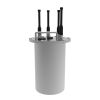Airmar EchoRange SS510 Smart Sonar Depth Sensor
Features
- Embedded transceiver with digital signal processing
- Outputs depth & temperature using NMEA 0183 data output
- Robust 316 stainless steel housing for fixed or portable mounting
- Free ground shipping
- Expedited repair and warranty service
- Lifetime technical support
- More
Overview
Pairing the Airmar EchoRange SS510 Smart Sensor with a computer or data logger provides a low-cost, portable hydrographic survey system. The EchoRange can also be fixed to a bridge abutment or pillar for unattended monitoring of scouring conditions.
Data Collection
The sensor digitally processes depth and water temperature signals to communicate data via NMEA 0183 protocol. Using NMEA 0183, the sensor easily interfaces with computers or data collection platforms with a data output rate of up to 10 times per second. The EchoRange is constructed with a robust stainless steel housing and has a measurement range from 0.4m to 200m with 0.01m resolution.
- Depth Reading Range: 0.4m to 200m
- Depth Resolution: 0.01m
- Depth Precision: 0.25% at full range
- Frequency: 200 kHz
- Beam Angle: 9°
- Temperature Sensor Accuracy: +/-0.05° C
- Temperature Resolution: 0.09° C
- Supply Voltage: 9 VDC to 40 VDC
- Average Current Draw: 150mA @ 13.6V
- Power & Data Cable: C304, 4 twisted shielded pairs, 20m
- NMEA0183 Baud Rate: 4,800
- Airmar EchoRange SS510 Smart Sonar Depth Sensor Specifications
- Airmar EchoRange SS510 Smart Sonar Depth Sensor Manual
- Airmar EchoRange SS510 Smart Sonar Depth Sensor Installation Guide
- Airmar EchoRange SS510 Smart Sonar Depth Sensor Support Drawings
- Airmar EchoRange SS510 Smart Sonar Depth Sensor Wiring Diagram
- Guide to Monitoring Scour at Bridges and Offshore Structures
In The News
Sargassum Surge: How Seaweed is Transforming our Oceans and Coastal Ecosystems
Until recently, Sargassum –a free-floating seaweed–was distributed throughout the Sargasso Sea , the north Caribbean Sea, and the Gulf of Mexico. But in the space of a decade, this seaweed has, as one scientist remarks , “Gone from a nonfactor to the source of a terrible crisis.” Driven by climate change, anomalous North Atlantic Oscillation in 2009-2010 and a glut of anthropogenic pollutants, sargassum has proliferated. Seasonally recurrent mats as deep as 7m now bloom in the “Great Atlantic Sargassum Belt” (GASB), which covers areas of the Atlantic from West Africa to the Caribbean Sea and Gulf of Mexico. Every year, millions of tons wash up along the shores of more than 30 countries . Dr.
Read MoreGreat Lakes Research Center: Designing Targeted Monitoring Solutions
According to the National Oceanic and Atmospheric Administration ( NOAA ), the Great Lakes have more miles of coastline than the contiguous Atlantic and Pacific coasts combined and contain 20 percent of the world's freshwater, making it a critical region to protect and conserve. Continuous monitoring and data-informed resource management are key components of managing waters in the region. Hayden Henderson, a research engineer with the Great Lakes Research Center (GLRC), designs and deploys monitoring platforms throughout the Great Lakes. With a background in environmental engineering, Henderson enjoyed the challenge of creating systems and making them work to obtain difficult, remote measurements.
Read MoreMonitoring Meadowbrook Creek: Real-Time Data Collection in an Urban Creek
Meadowbrook Creek in Syracuse, New York, has been monitored by Syracuse University (SU) faculty and students for over a decade. Originally established by Dr. Laura Lautz in 2012, the early years of the program focused on collecting grab water samples for laboratory analysis and evaluating the impact of urban land use, human activities, and natural processes on water resources. Tao Wen , an Assistant Professor in SU’s Department of Earth and Environmental Sciences, took over the program in 2020 and upgraded the existing systems to include 4G modems that allowed for real-time data viewing. [caption id="attachment_39339" align="alignnone" width="940"] An overview of the Fellows Ave monitoring station along Meadowbrook Creek.
Read More

















